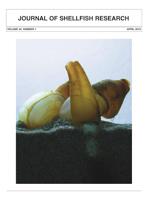This research examined the individual effects of temperature and ration on growth and survival of juveniles of the Pacific geoduck Panopea generosa Gould, 1850, in two separate experiments. Growth parameters measured included shell length, daily shell increment, individual total body wet weight, specific growth rate, individual total body dry weight, and total body ash-free dry weight (AFDW). Larvae in all treatments were fed a binary microalgal diet of Chaetoceros muelleri and Tisochrysis lutea mixed at a 1:1 ratio by AFDW. The temperature experiment examined the effect of four temperatures (7°C, 11°C, 15°C, and 19°C) using two geoduck cohorts. One cohort was comprised of larger juveniles (mean initial shell length ± SE, 3.22 ± 0.05 mm) and the other included smaller individuals (0.54 ± 0.01 mm) which were cultured for 28 days and 21 days, respectively. Using a separate cohort, the foodration experiment examined the effect of nine rations (0.0, 1.0, 2.0, 4.0, 8.0, 16.0, 32.0, 64.0, and 128.0 × 106 equivalent T. lutea cells per individual per day) on four size classes of geoduck juveniles obtained from the same spawning batch (mean initial shell length ± SE, size class 1,2.34 ± 0.04 mm; size class 2, 3.32 ± 0.04 mm; size class 3,4.13 ± 0.04 mm; and size class 4, 4.98 ± 0.04 mm) for 7 days. On the final sampling day, there were significant differences among all four temperatures for all growth parameters except AFDW, with each parameter increasing significantly for each increase in temperature. For AFDW, there were no significant differences between 7°C and 19°C, nor between 11°C and 15°C, with the first set of two temperatures producing juveniles with significantly less AFDW than the latter set. In general, optimal ration levels increased with increasing geoduck size. To optimize growth in shell length, individual total body wet weight, and/or individual total body dry weight, the following rations are recommended for size classes 1, 2, 3, and 4, respectively: 4.0 or 8.0, 8.0, 16.0 or 32.0, and 32.0 or 64.0 × 106 equivalent T. lutea cells per individual per day. Refinement of an understanding of optimum juvenile geoduck culture conditions contributes to the general knowledge of the species’ physiology and helps maximize the commercial hatchery production of geoduck seed.
How to translate text using browser tools
1 March 2015
Temperature and Food-Ration Optimization in the Hatchery Culture of Juveniles of the Pacific Geoduck Panopea generosa
Bianca Arney,
Wenshan Liu,
Ian Forster,
R. Scott Mckinley,
Christopher M. Pearce
ACCESS THE FULL ARTICLE

Journal of Shellfish Research
Vol. 34 • No. 1
March 2015
Vol. 34 • No. 1
March 2015
aquaculture
food ration
juveniles
Pacific geoduck
Panopea generosa
temperature




